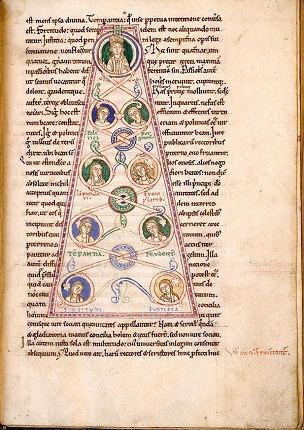 Macrobius: Commentary on Somnium Scipionis (Petyt Ms. 511.10) This finely illuminated manuscript of the mid 12th century is believed to be the oldest manuscript in the Inn’s possession. The work is a commentary on The Dream of Scipio from book VI of Cicero’s De Republica, written by the Latin grammarian and philosopher Ambrosius Theodosius Macrobius (395-423 A.D.). Cicero’s text itself is lost, but it has been preserved in the commentary of Macrobius. © Ian Jones
Macrobius: Commentary on Somnium Scipionis (Petyt Ms. 511.10) This finely illuminated manuscript of the mid 12th century is believed to be the oldest manuscript in the Inn’s possession. The work is a commentary on The Dream of Scipio from book VI of Cicero’s De Republica, written by the Latin grammarian and philosopher Ambrosius Theodosius Macrobius (395-423 A.D.). Cicero’s text itself is lost, but it has been preserved in the commentary of Macrobius. © Ian Jones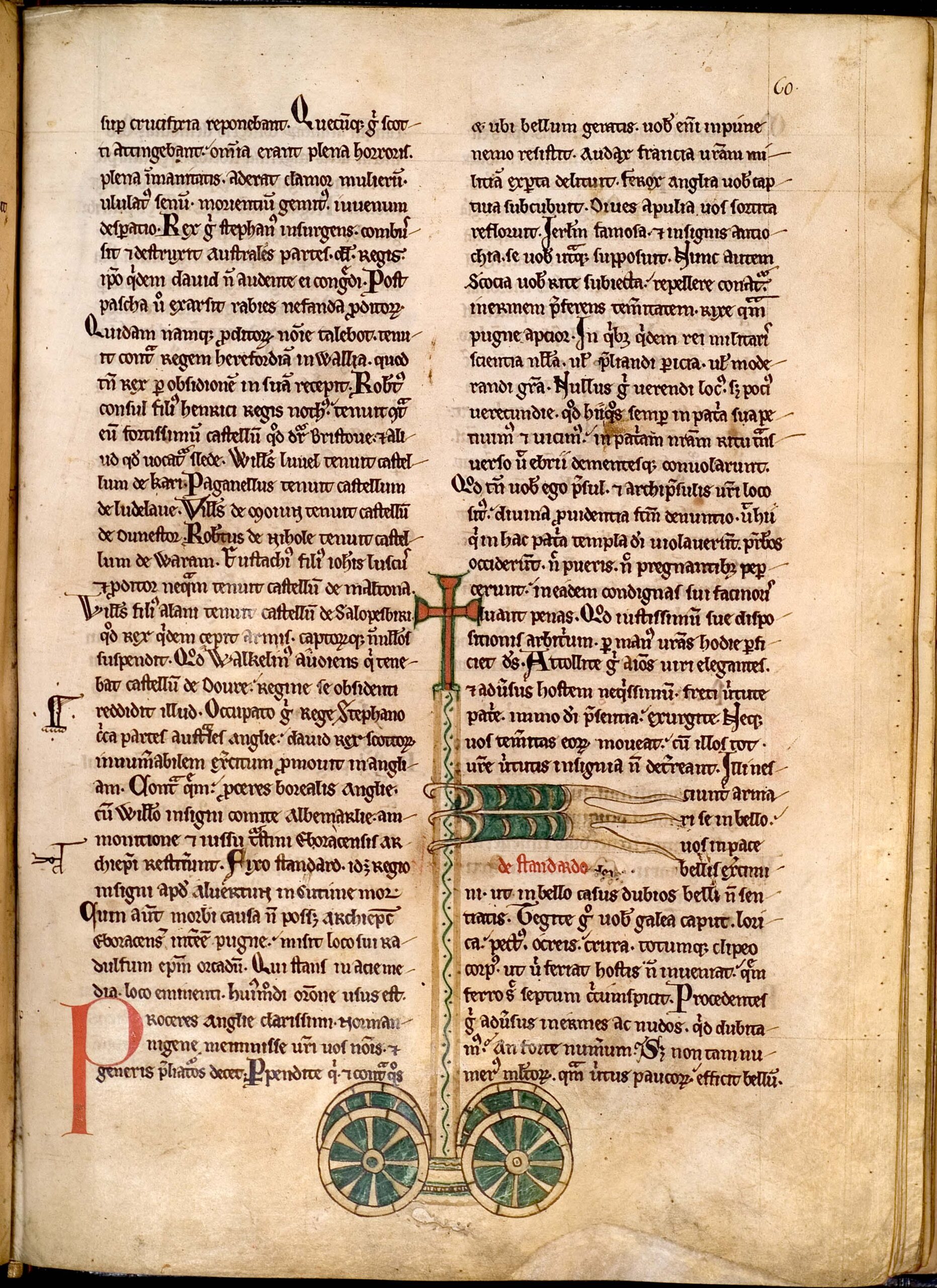 Roger de Hoveden: Chronica (Petyt Ms. 511.2) Roger de Hoveden (i.e. of Howden, in East Yorkshire) served as a clerk at the court of Henry II from about 1173 until after the king's death in 1189. After leaving royal service, probably by 1192, he began writing his Historia Anglorum or Chronica, a history of England from the time of Bede. Possibly written in the Durham scriptorium, and known to have been in the possession of the Abbey of Rievaulx early in the 13th century, this is one of the earliest surviving manuscripts of Hoveden's work. © Ian Jones
Roger de Hoveden: Chronica (Petyt Ms. 511.2) Roger de Hoveden (i.e. of Howden, in East Yorkshire) served as a clerk at the court of Henry II from about 1173 until after the king's death in 1189. After leaving royal service, probably by 1192, he began writing his Historia Anglorum or Chronica, a history of England from the time of Bede. Possibly written in the Durham scriptorium, and known to have been in the possession of the Abbey of Rievaulx early in the 13th century, this is one of the earliest surviving manuscripts of Hoveden's work. © Ian Jones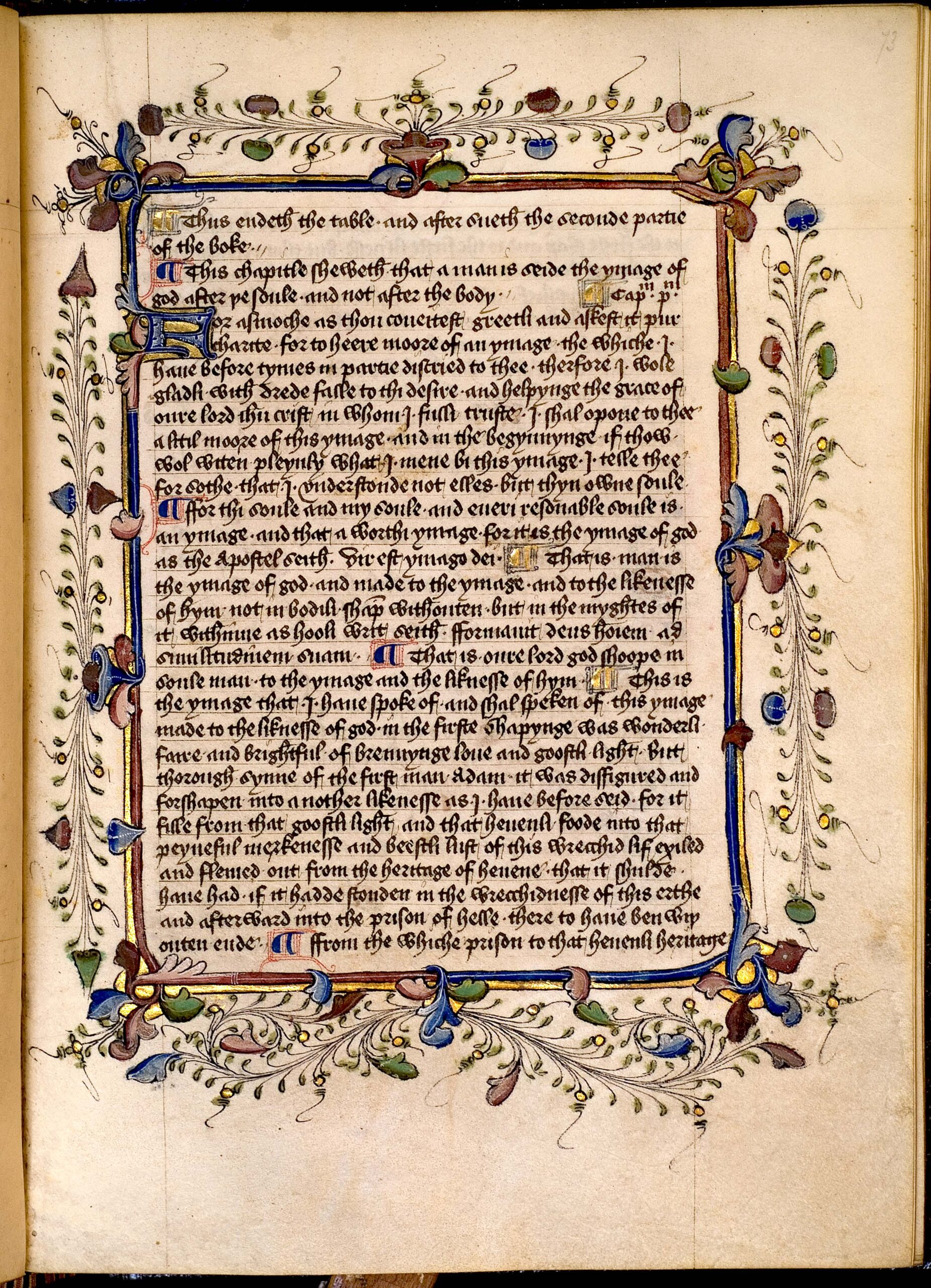 Walter Hilton: The Ladder of Perfection (Petyt Ms. 524) Walter Hilton (d.1396) was an Augustinian canon of Thurgarton Priory, near Newark in Nottinghamshire. He wrote several mystical works, some in English and some in Latin, which were widely read in England in the 15th century. The Ladder of Perfection is the most famous of Hilton’s writings. Addressed to a single woman recluse, it describes in two stages, separated by a mystical ‘dark night’, the reformation of the defaced image of God in the soul. This manuscript dates from the first half of the 15th century. © Ian Jones
Walter Hilton: The Ladder of Perfection (Petyt Ms. 524) Walter Hilton (d.1396) was an Augustinian canon of Thurgarton Priory, near Newark in Nottinghamshire. He wrote several mystical works, some in English and some in Latin, which were widely read in England in the 15th century. The Ladder of Perfection is the most famous of Hilton’s writings. Addressed to a single woman recluse, it describes in two stages, separated by a mystical ‘dark night’, the reformation of the defaced image of God in the soul. This manuscript dates from the first half of the 15th century. © Ian Jones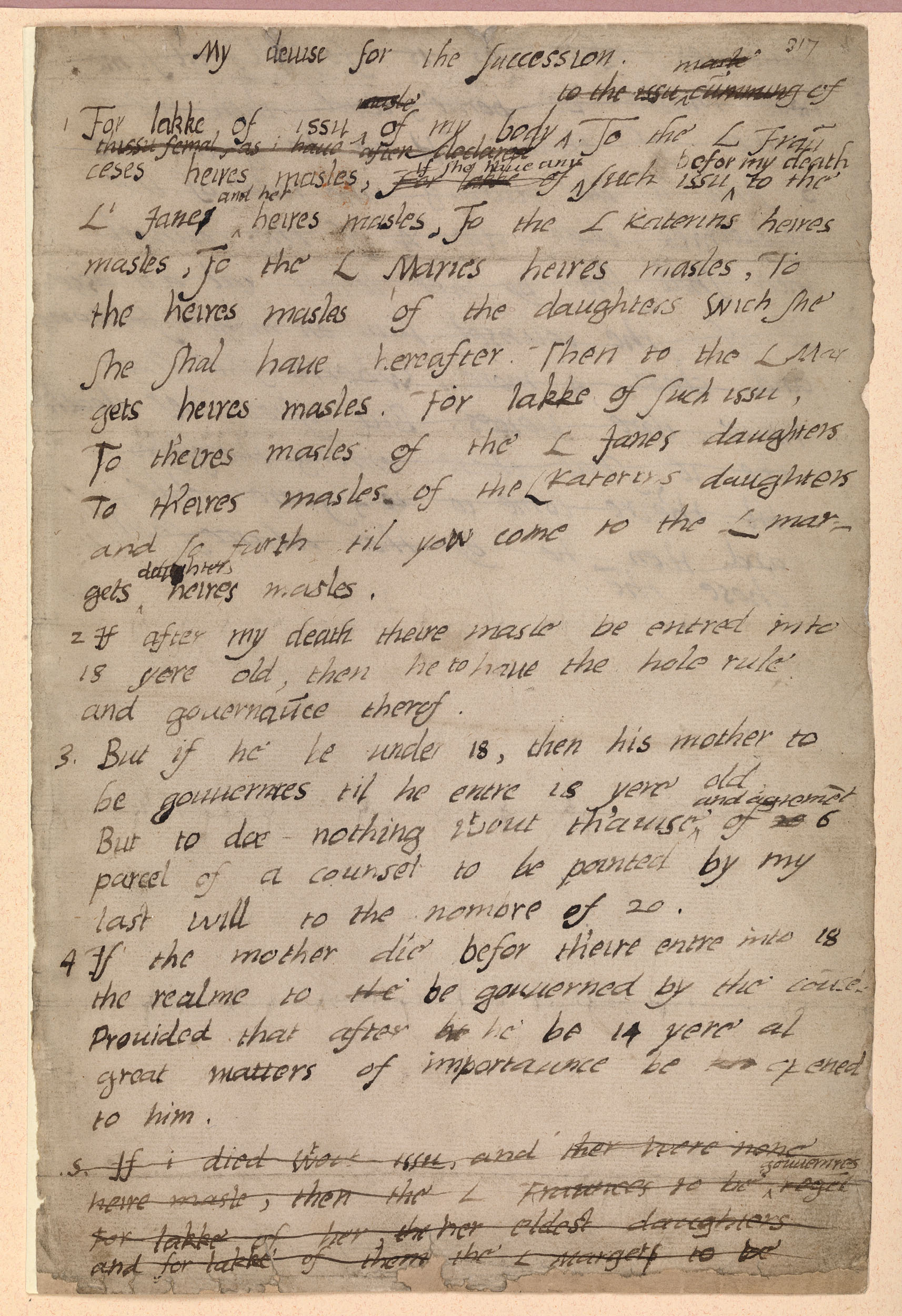 Edward VI: My Devise for the Succession (Petyt Ms. 538.47, fol. 317) The dying King Edward VI, then aged 16, prepared his "devise for the succession" in the second week of June 1553. This draft is in his own handwriting. Edward was the only surviving son of Henry VIII, by Henry's third wife, Jane Seymour. At the instigation of his Protector, the Duke of Northumberland, he drew up this devise in an attempt to exclude his half-sisters Mary and Elizabeth in favour of his cousin Lady Jane Grey, Northumberland's daughter-in-law. © Inner Temple Library
Edward VI: My Devise for the Succession (Petyt Ms. 538.47, fol. 317) The dying King Edward VI, then aged 16, prepared his "devise for the succession" in the second week of June 1553. This draft is in his own handwriting. Edward was the only surviving son of Henry VIII, by Henry's third wife, Jane Seymour. At the instigation of his Protector, the Duke of Northumberland, he drew up this devise in an attempt to exclude his half-sisters Mary and Elizabeth in favour of his cousin Lady Jane Grey, Northumberland's daughter-in-law. © Inner Temple Library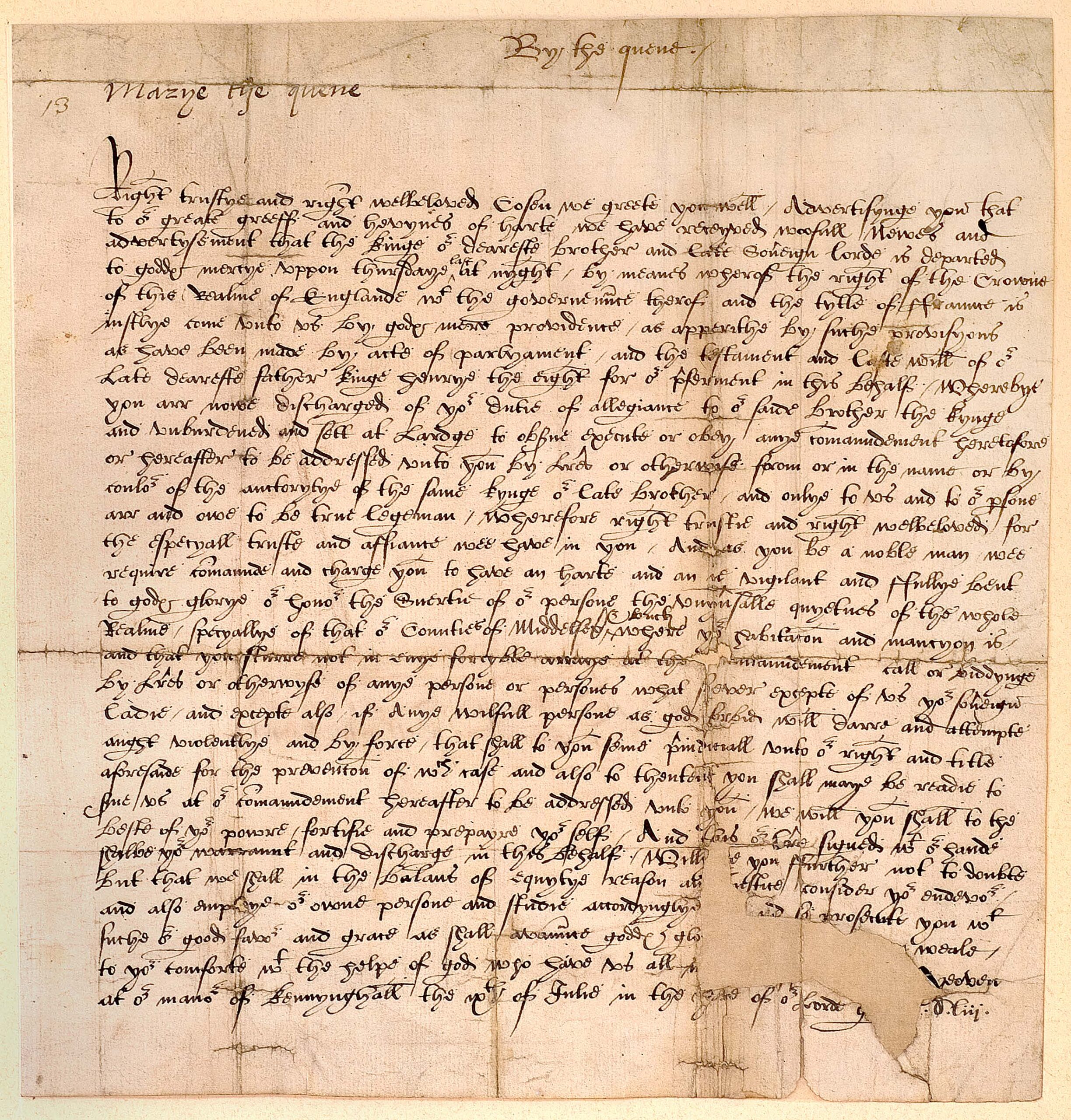 Mary I: Letter to Sir Edward Hastings (Petyt Ms. 538.47 fol. 13) A letter under signet and sign manual "Marye the Quene", written at the manor of Kenninghall (Norfolk) on 9th July 1553, three days after the death of Edward VI. Mary announces the death of Edward "upon Thursday last at night", by which the crown had come to her “by act of parliament and by the testament and last will of our late dearest father King Henry the Eighth”. She orders Hastings to secure “the surety of our person, the universal quietness of the whole realm, specially that of our counties of Middlesex and Bucks”. © Ian Jones
Mary I: Letter to Sir Edward Hastings (Petyt Ms. 538.47 fol. 13) A letter under signet and sign manual "Marye the Quene", written at the manor of Kenninghall (Norfolk) on 9th July 1553, three days after the death of Edward VI. Mary announces the death of Edward "upon Thursday last at night", by which the crown had come to her “by act of parliament and by the testament and last will of our late dearest father King Henry the Eighth”. She orders Hastings to secure “the surety of our person, the universal quietness of the whole realm, specially that of our counties of Middlesex and Bucks”. © Ian Jones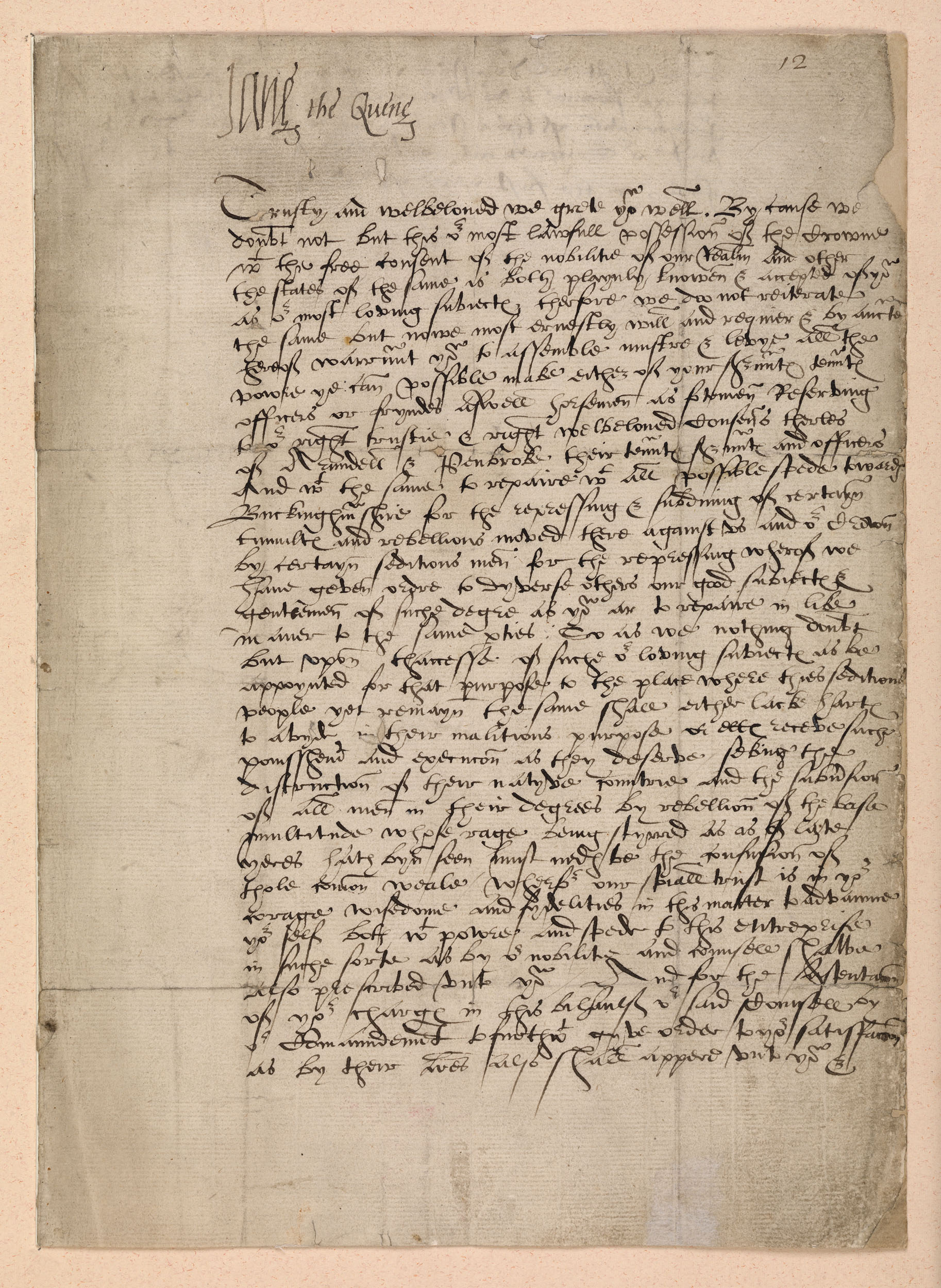 Lady Jane Grey: Letter to Sir John St Lowe & Sir Anthony Kingston (Petyt Ms. 538.47 fol. 12) A letter under signet and sign manual "Jane the Quene" "given under the signet at the Tower of London the eighteenth July in the first year of our reign [1553]". Jane requires the recipients "to assemble, muster and levy all the power you can possibly make...to repair with all possible speed towards Buckingham-shire for the repressing and subduing of certain tumults and rebellions moved there against us and our crown by certain seditious men". The nine-day reign of Lady Jane Grey ended the following day and Mary Tudor was proclaimed queen. Lady Jane was imprisoned in the Tower of London, where both she and her husband were executed in February 1554. © Inner Temple Library
Lady Jane Grey: Letter to Sir John St Lowe & Sir Anthony Kingston (Petyt Ms. 538.47 fol. 12) A letter under signet and sign manual "Jane the Quene" "given under the signet at the Tower of London the eighteenth July in the first year of our reign [1553]". Jane requires the recipients "to assemble, muster and levy all the power you can possibly make...to repair with all possible speed towards Buckingham-shire for the repressing and subduing of certain tumults and rebellions moved there against us and our crown by certain seditious men". The nine-day reign of Lady Jane Grey ended the following day and Mary Tudor was proclaimed queen. Lady Jane was imprisoned in the Tower of London, where both she and her husband were executed in February 1554. © Inner Temple Library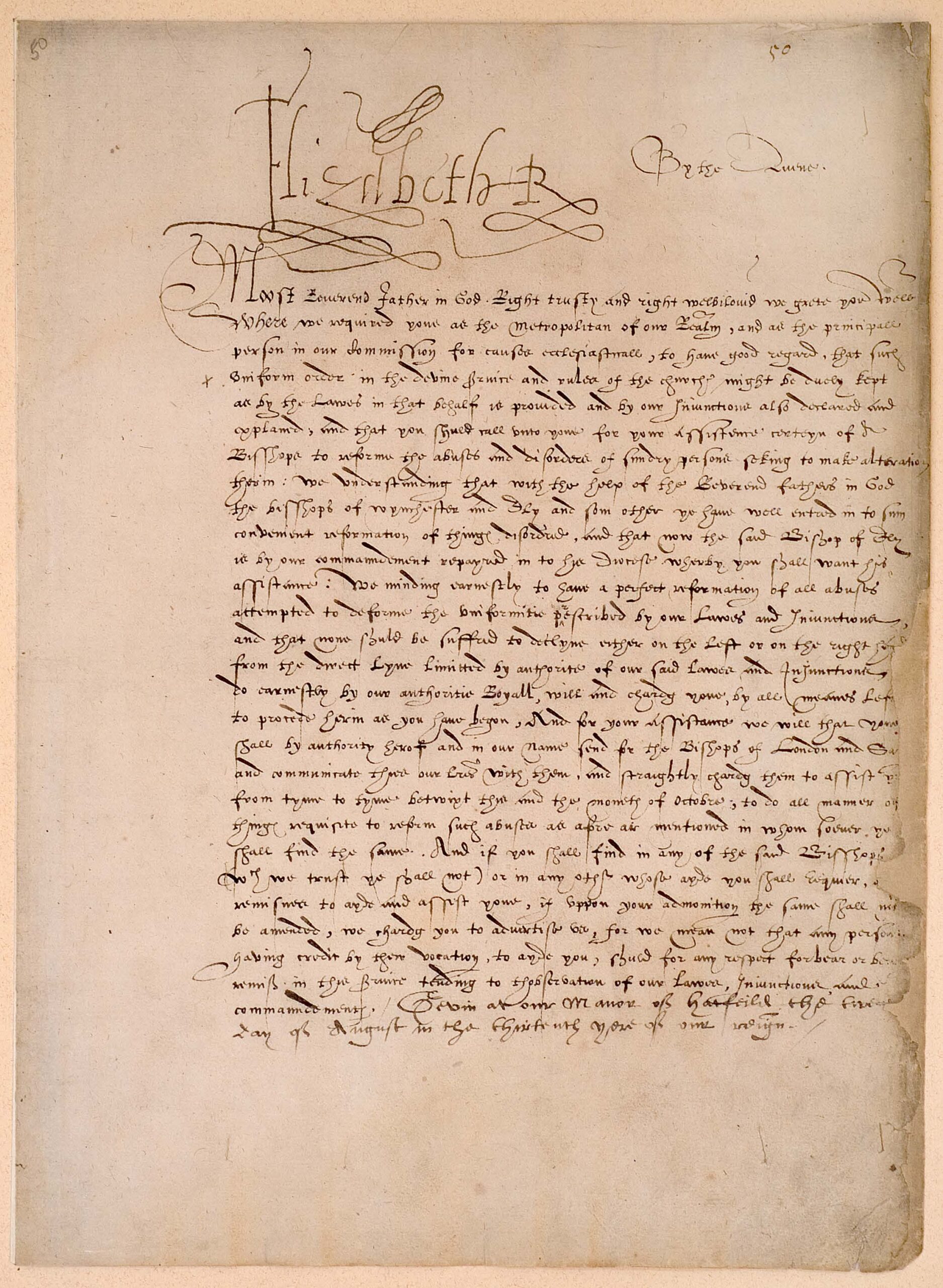 Elizabeth I: Letter to Matthew Parker, Archbishop of Canterbury (Petyt Ms. 538.47 fol. 50) A letter under signet and sign manual "Elizabeth R", "given at our manor of Hatfield the twentieth day of August in the thirteenth year of our reign [1571]", concerning the observance of uniformity in religion. © Ian Jones
Elizabeth I: Letter to Matthew Parker, Archbishop of Canterbury (Petyt Ms. 538.47 fol. 50) A letter under signet and sign manual "Elizabeth R", "given at our manor of Hatfield the twentieth day of August in the thirteenth year of our reign [1571]", concerning the observance of uniformity in religion. © Ian Jones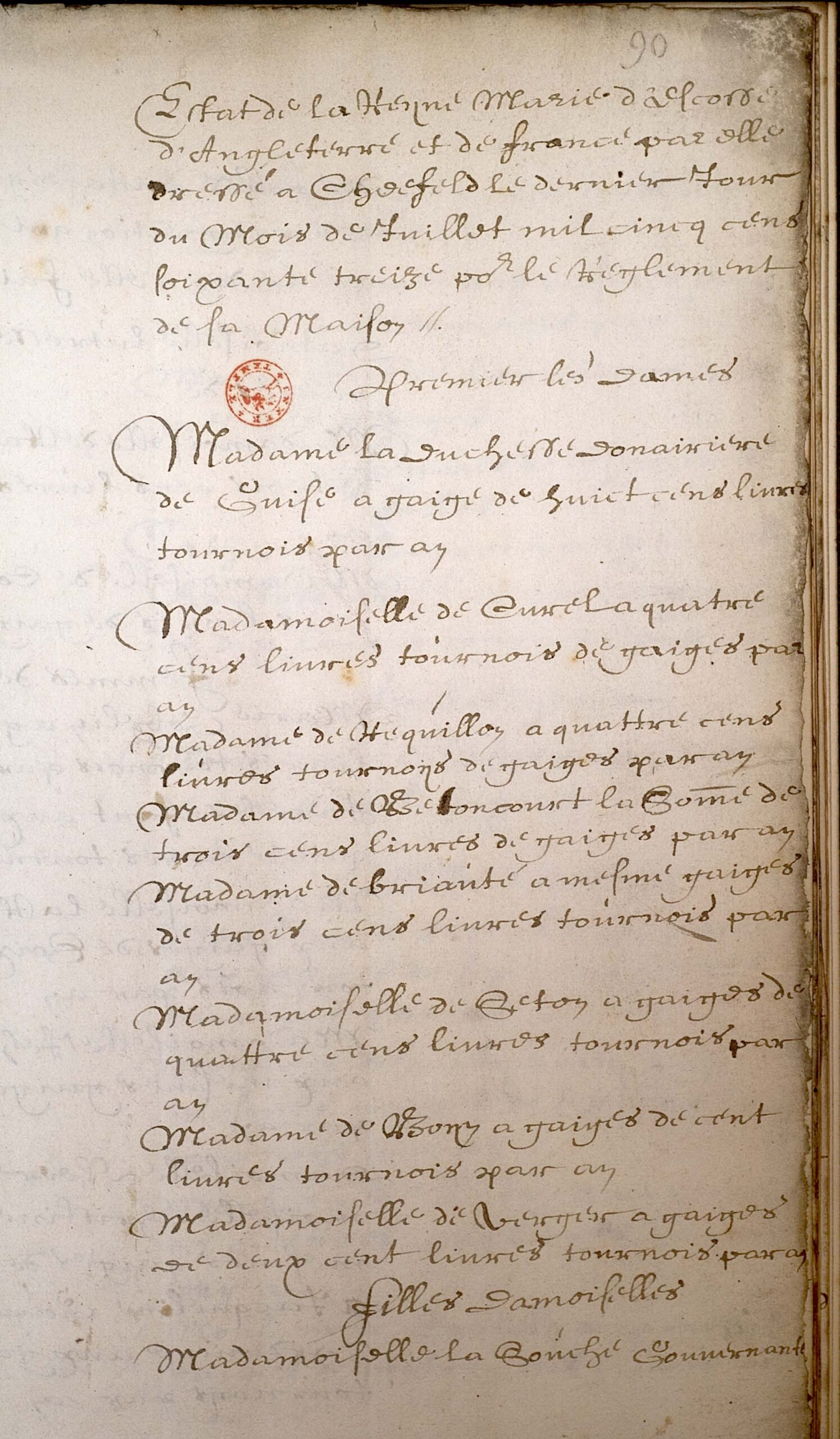 Mary Queen of Scots: Account of the Household at Sheffield, 1573 (Misc. Ms. 41 no. 90) An account, in French, of the household of “Queen Mary of Scotland, England and France”, then confined in Sheffield Castle, dated 31 July 1573. © Ian Jones
Mary Queen of Scots: Account of the Household at Sheffield, 1573 (Misc. Ms. 41 no. 90) An account, in French, of the household of “Queen Mary of Scotland, England and France”, then confined in Sheffield Castle, dated 31 July 1573. © Ian Jones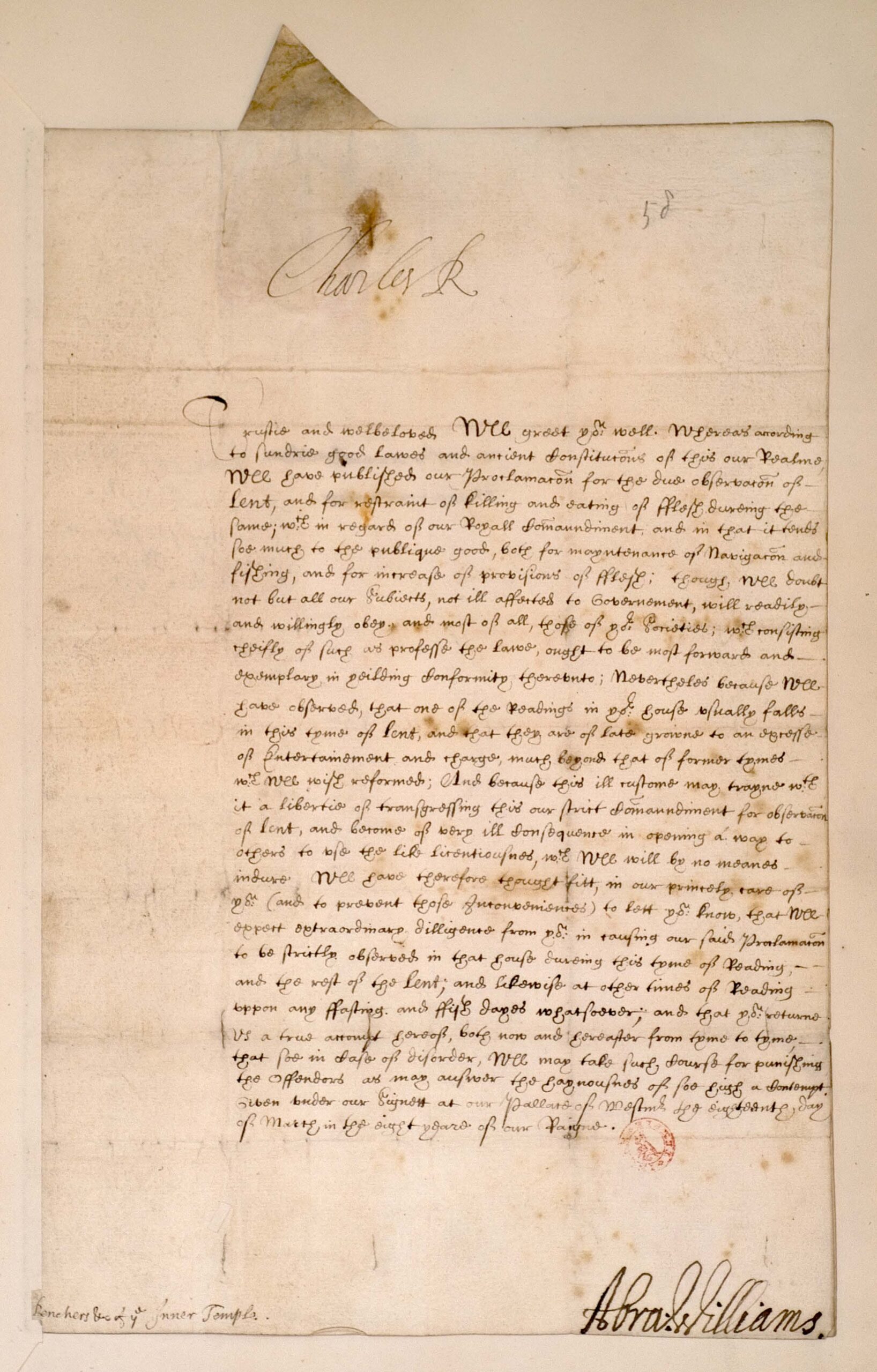 Charles I: Letter to the Benchers of the Inner Temple (Misc. Ms. 30 fol. 58) A letter of Charles I, "given under our signet at our Palace of Westminster the eighteenth day of March in the eighth year of our reign [1633]". The king refers to "our proclamation for the due observation of Lent, and for restraint of killing and eating of flesh during the same". He notes that the Readings at Lent and other times "are of late grown to an excess of entertainment and charge, much beyond that of former times" and requests compliance with the proclamation. © Ian Jones
Charles I: Letter to the Benchers of the Inner Temple (Misc. Ms. 30 fol. 58) A letter of Charles I, "given under our signet at our Palace of Westminster the eighteenth day of March in the eighth year of our reign [1633]". The king refers to "our proclamation for the due observation of Lent, and for restraint of killing and eating of flesh during the same". He notes that the Readings at Lent and other times "are of late grown to an excess of entertainment and charge, much beyond that of former times" and requests compliance with the proclamation. © Ian Jones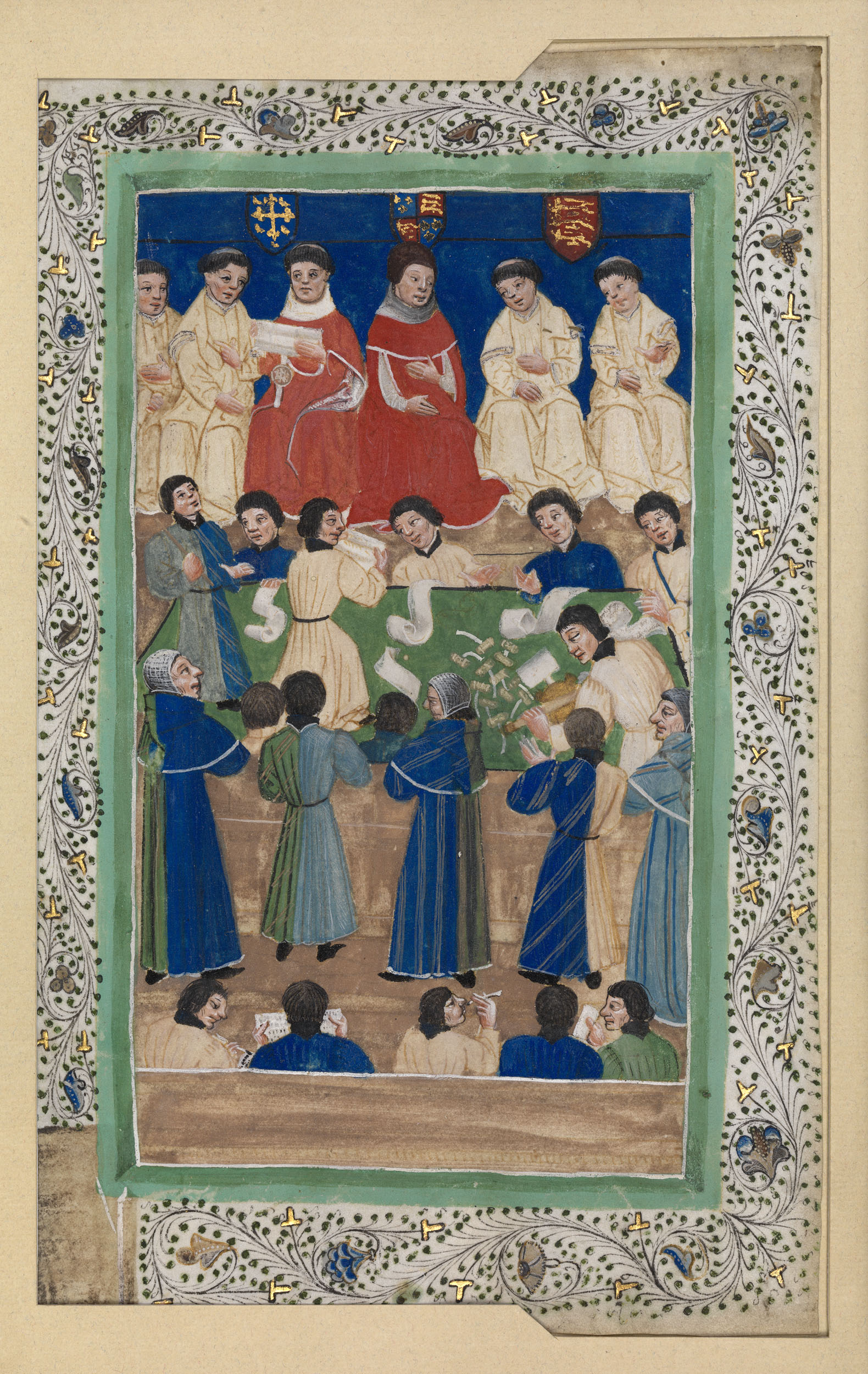 Court of Chancery (Misc. Ms. 188) One of four illuminations on vellum, the earliest known depictions of the English courts and court dress. They date from about 1460 and show the four courts at Westminster Hall. The illuminations were presented to the Inn by Lord Darling (Treasurer 1914-1915), who had purchased them at Christie’s in 1894. © Inner Temple Library
Court of Chancery (Misc. Ms. 188) One of four illuminations on vellum, the earliest known depictions of the English courts and court dress. They date from about 1460 and show the four courts at Westminster Hall. The illuminations were presented to the Inn by Lord Darling (Treasurer 1914-1915), who had purchased them at Christie’s in 1894. © Inner Temple Library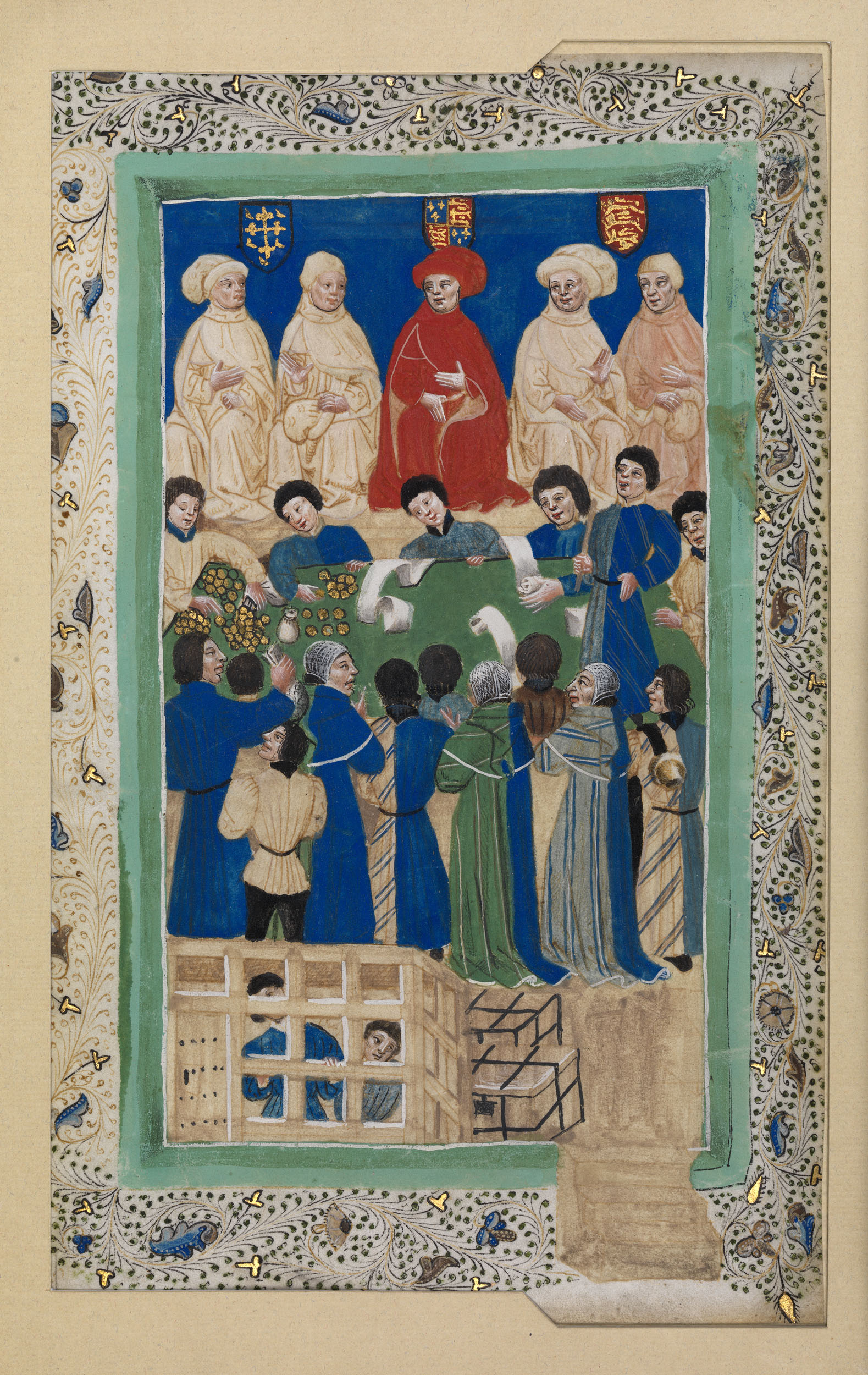 Court of Exchequer (Misc. Ms. 188) One of four illuminations on vellum, the earliest known depictions of the English courts and court dress. They date from about 1460 and show the four courts at Westminster Hall. The illuminations were presented to the Inn by Lord Darling (Treasurer 1914-1915), who had purchased them at Christie’s in 1894. © Inner Temple Library
Court of Exchequer (Misc. Ms. 188) One of four illuminations on vellum, the earliest known depictions of the English courts and court dress. They date from about 1460 and show the four courts at Westminster Hall. The illuminations were presented to the Inn by Lord Darling (Treasurer 1914-1915), who had purchased them at Christie’s in 1894. © Inner Temple Library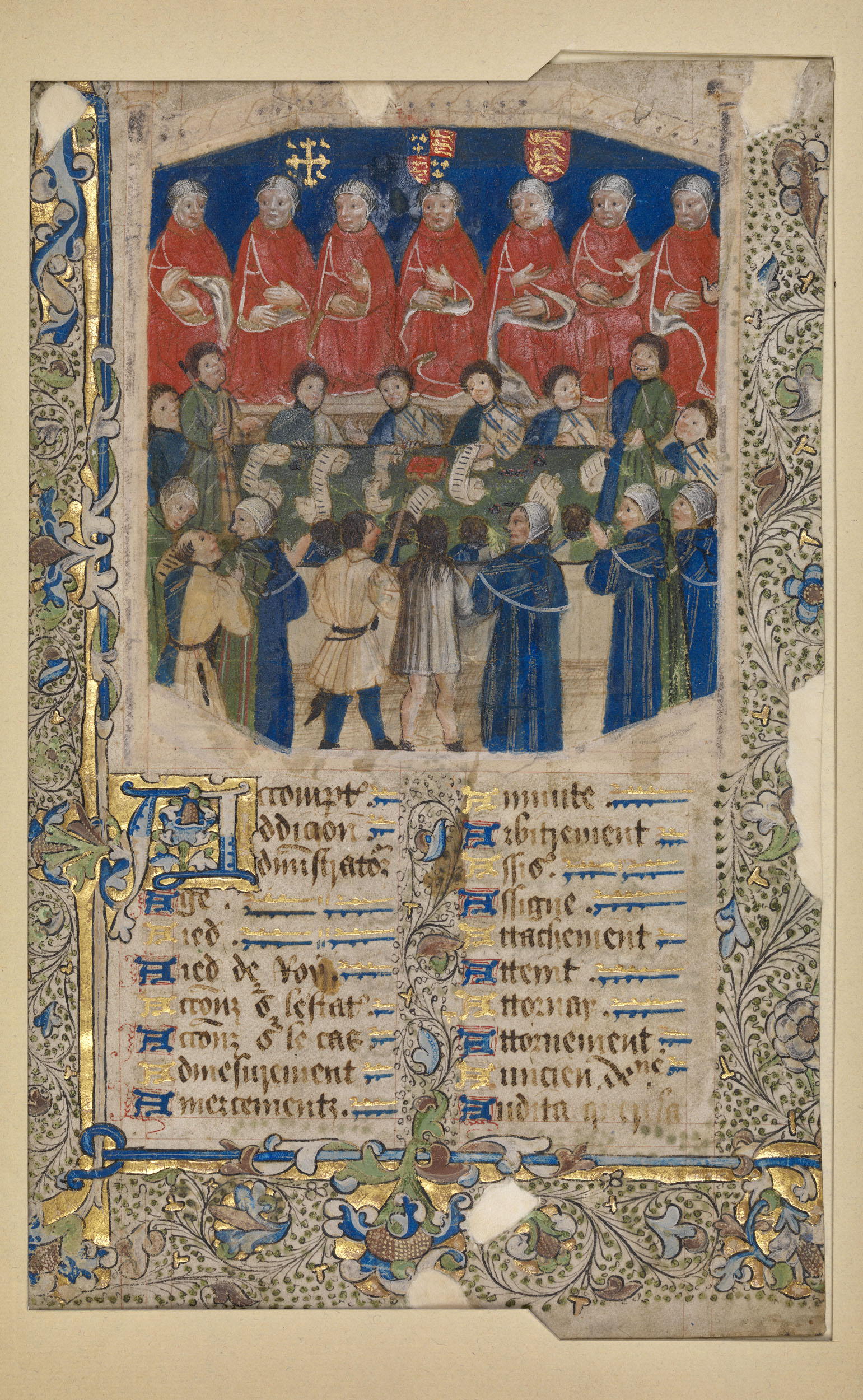 Court of Common Pleas (Misc. Ms. 188) One of four illuminations on vellum, the earliest known depictions of the English courts and court dress. They date from about 1460 and show the four courts at Westminster Hall. The alphabetical table which begins at the foot of the Court of Common Pleas illumination and continues on its other side indicates that they may have originated as illustrations to a legal treatise, possibly an abridgment of the law predating that of Fitzherbert (1516) but now lost. The illuminations were presented to the Inn by Lord Darling (Treasurer 1914-1915), who had purchased them at Christie’s in 1894. © Inner Temple Library
Court of Common Pleas (Misc. Ms. 188) One of four illuminations on vellum, the earliest known depictions of the English courts and court dress. They date from about 1460 and show the four courts at Westminster Hall. The alphabetical table which begins at the foot of the Court of Common Pleas illumination and continues on its other side indicates that they may have originated as illustrations to a legal treatise, possibly an abridgment of the law predating that of Fitzherbert (1516) but now lost. The illuminations were presented to the Inn by Lord Darling (Treasurer 1914-1915), who had purchased them at Christie’s in 1894. © Inner Temple Library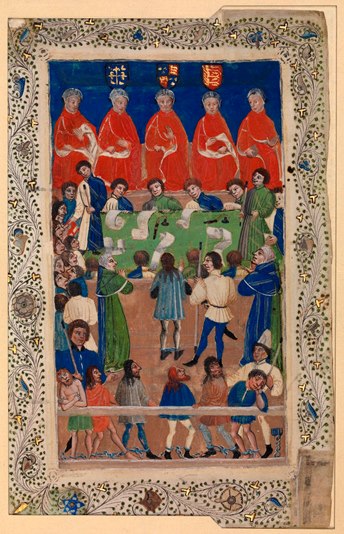 Court of Kings Bench (Misc. Ms. 188) One of four illuminations on vellum, the earliest known depictions of the English courts and court dress. They date from about 1460 and show the four courts at Westminster Hall. The illuminations were presented to the Inn by Lord Darling (Treasurer 1914-1915), who had purchased them at Christie’s in 1894. © Inner Temple Library
Court of Kings Bench (Misc. Ms. 188) One of four illuminations on vellum, the earliest known depictions of the English courts and court dress. They date from about 1460 and show the four courts at Westminster Hall. The illuminations were presented to the Inn by Lord Darling (Treasurer 1914-1915), who had purchased them at Christie’s in 1894. © Inner Temple Library

